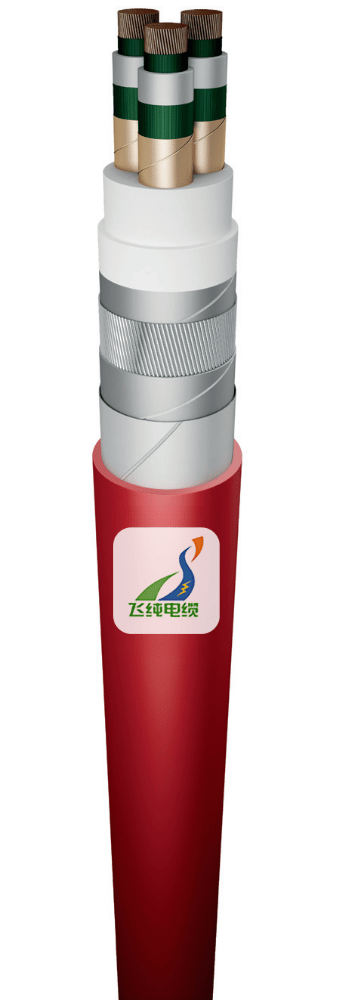Type YUHKGXSekFoyn 3.6/6 kV Power cables
High strength mining power cable, individually tinned copper wire shield, class 5 flexible copper core,
cross-linked polyethylene insulation, PVC sheath, overall shield,
round steel wire armor, longitudinal seal, outer sheath
flame retardant PVC


These cables are specially designed for underground mining applications where both electrical performance and high mechanical durability are essential.
They are used in power distribution networks in mines with a nominal voltage of up to 6 kV and are approved for use in both non-methane and methane hazardous areas (including zones with potential coal dust explosion risks).
Construction and Materials
Conductors:
Type: Round, multi-strand, individually tinned copper wires.
Compaction: The conductors are compacted (Class 2 according to EN 60228) for flexibility and improved conductivity.
Insulation:
Material: Cross-linked polyethylene (XLPE) – specifically Type DIX 3 (PN-HD 620 S1:2002).
Color: Natural (undyed) appearance.
Individual Shielding:
Each working conductor is wrapped with its own shield. This can be in the form of a conductive tape or a polyethylene-based conductor shield combined with a copper tape.
Filling and Inner Sheath:
Filling: A layer of non-vulcanized rubber or tire-grade PVC is used as a filler to stabilize the cable structure.
Inner Sheath: Made of PVC (type DMV 31 according to PN-HD 620 S1:2002), providing an additional insulation barrier.
Overall Shielding:
An extra overall shield of copper tape is applied over the insulated conductors for enhanced electromagnetic compatibility and additional protection.
Armor:
Type: A robust layer of round steel wires is used as armor to protect the cable against mechanical stresses and impacts.
Sealing and Outer Sheath:
Longitudinal Seal: A water-swelling tape is applied along the length of the cable to provide a tight seal against moisture ingress.
Outer Sheath: The final protective layer is a flame-retardant PVC (also type DMV 31), which ensures that the cable resists flame propagation according to IEC standards (IEC 60332-1-2 and IEC 60332-3-24C).
Technical Specifications
Voltage Rating: Suitable for systems operating at 3.6 kV up to 6 kV.
Temperature Ranges:
Operating Conductor Temperature: Up to +90°C.
Minimum Ambient Temperature (permanent laying): -30°C.
Installation Temperature (without heating): Down to -50°C.
Short-Circuit Temperature: Can reach up to +250°C.
Mechanical Flexibility:
Minimum bending radius is specified as 12 times the cable's outer diameter.
Testing:
Cables are subjected to a 15 kV AC test for 5 minutes at 50 Hz.
Standards:
Construction follows ZN-TF 203:2006.
Insulation and sheath materials comply with relevant PN-HD 620 S1:2002 standards.
Performance Characteristics
Flame Retardancy:
The outer sheath is made from flame-retardant PVC, meeting IEC 60332-1-2 and IEC 60332-3-24C standards.
Ampacity and Electrical Properties:
Detailed tables specify conductor sizes (e.g., 3x25, 3x35, 3x50, etc.), insulation and sheath thicknesses, cable diameter, weight, and conductor resistance at 20°C.
Additional tables provide the current-carrying capacity (ampacity), inductance, and reactance per unit length for each conductor size.
When cables are installed in parallel (stacked on one another), correction factors are provided to adjust ampacity based on the number of cables and ambient temperature (with specific coefficients for setups of 1, 2, 3, 6, or 9 cables and for ambient temperatures ranging from 30°C to 55°C).
Applications
Primary Use:
These cables are used in underground power distribution systems within mining environments.
Hazardous Areas:
They are designed for use in both non-methane and methane zones, including areas classified as “a”, “b”, or “c” hazards for methane or coal dust explosions.
Installation Conditions:
The armored versions are suitable for installation in shafts and sloping mine workings, especially where the slope exceeds 45°.
Certifications and Packaging
Certifications:
The cables are certified by bodies such as EMAG and WUG.
They comply with RoHS and are designed to operate reliably within the temperature range (max +90°C, min -5°C for certain certifications).
Packaging:
Typically supplied in reels of 500 or 1000 meters, with options available for other lengths and packaging configurations.
Summary
Type YUHKGXSekFoyn 3.6/6 kV mining power cables offer a robust, flame-retardant, and highly insulated solution for challenging underground mining environments.
Their construction—with individually shielded, tinned copper conductors, cross-linked polyethylene insulation, a multi-layered PVC protective system, and steel wire armor—ensures they meet the stringent safety and performance standards required for hazardous areas. These cables provide reliable performance in environments prone to mechanical stress, temperature extremes, and potentially explosive atmospheres.

Frequently Asked Questions (FAQ)
Q: What is the primary application of these cables?
A: They are designed for underground mining power distribution, especially in environments with potential methane or coal dust explosion hazards.
Q: What voltage range do these cables support?
A: They are engineered for systems with nominal voltages up to 6 kV, with designs applicable for 3.6 kV and 6 kV systems.
Q: What type of conductors are used in this cable?
A: The cable uses round, multi-strand, individually tinned copper conductors compacted to Class 2 per EN 60228 for enhanced flexibility and conductivity.
Q: Why is individual shielding important in these cables?
A: Individual shielding on each conductor reduces electromagnetic interference and ensures stable performance in harsh conditions.
Q: What insulation material is employed?
A: The insulation is made of cross-linked polyethylene (XLPE), specifically Type DIX 3, which offers excellent electrical and thermal properties.
Q: What are the benefits of using XLPE insulation?
A: XLPE provides high thermal resistance, superior electrical properties, and mechanical robustness, ideal for the extreme conditions found in mining environments.
Q: What material forms the inner sheath of the cable?
A: An inner sheath of PVC (type DMV 31) adds another layer of insulation and mechanical protection.
Q: How is overall electromagnetic shielding achieved?
A: A continuous overall shield made from copper tape is applied over the insulated conductors to further mitigate interference.
Q: What type of armor does the cable have?
A: The cable is protected by a robust layer of round steel wire armor, which guards against mechanical impacts and environmental stresses.
Q: How does the cable prevent water ingress?
A: A water-swelling, longitudinal sealing tape is incorporated to provide a tight, moisture-resistant seal along the cable’s length.
Q: What flame retardant properties does the cable possess?
A: The outer sheath is made of flame-retardant PVC that complies with IEC 60332-1-2 and IEC 60332-3-24C standards, limiting flame spread.
Q: Which standards does this cable conform to?
A: It meets ZN-TF 203:2006 standards and uses materials per PN-HD 620 S1:2002, alongside relevant IEC standards for flame retardancy.
Q: What is the maximum operating temperature for the cable’s conductor?
A: The conductor is designed to operate at temperatures up to +90°C.
Q: What are the minimum temperature requirements for installation and operation?
A: For permanent installations, the cable can operate in ambient temperatures as low as -30°C and down to -50°C during installation without heating.
Q: How high can the conductor temperature reach during a short circuit?
A: In short-circuit conditions, the conductor temperature may reach up to +250°C.
Q: What is the specified minimum bending radius?
A: The minimum bending radius is 12 times the cable’s outer diameter (12 x D), ensuring safe handling and installation.
Q: What high-voltage test do these cables undergo?
A: Each cable is tested at 15 kV AC for 5 minutes at 50 Hz to confirm the integrity of its insulation.
Q: How do the tinned copper conductors enhance performance?
A: Tinned copper improves corrosion resistance, electrical conductivity, and durability—key factors in the demanding conditions of mining environments.
Q: What role does the overall copper tape shield play?
A: It provides additional electromagnetic interference protection, ensuring stable operation even in electrically noisy environments.
Q: How is current-carrying capacity determined for these cables?
A: Ampacity is calculated based on conductor size, insulation properties, ambient temperature, and installation conditions, with correction factors provided for parallel cable layouts.
Q: What factors influence the cable's current-carrying capacity?
A: Factors include conductor cross-sectional area, ambient and operating temperatures, installation configuration, and the number of cables installed together.
Q: Are these cables suitable for hazardous mining areas?
A: Yes, they are specifically designed for hazardous areas, including zones with methane presence or coal dust, meeting safety requirements for explosion risks.
Q: What is the function of the non-vulcanized rubber or tire-grade PVC filling?
A: This filling stabilizes the cable structure, enhances mechanical strength, and contributes to the overall durability.
Q: How does the steel wire armor contribute to the cable’s performance?
A: The steel wire armor protects the cable from mechanical damage, impacts, and abrasion, ensuring longevity in rugged mining conditions.
Q: Can these cables be installed in steep or inclined mine shafts?
A: Yes, their flexible design and robust armor make them suitable for installation in shafts and slopes exceeding 45°.
Q: How does the cable’s construction aid in minimizing maintenance needs?
A: The use of high-quality, durable materials, effective moisture sealing, and flame-retardant properties helps reduce failures and maintenance requirements over time.
Q: What is the significance of the water-swelling sealing tape?
A: It provides a long-lasting seal that prevents water and moisture from penetrating the cable, protecting the internal components.
Q: How do the cable’s resistance and inductance values affect its performance?
A: Defined resistance, inductance, and reactance values ensure predictable electrical performance, which is critical for proper system design and safe operation in mining networks.
Q: How is electromagnetic interference (EMI) mitigated in this cable?
A: EMI is minimized through the dual-layer shielding system—individual conductor shields and an overall copper tape shield—enhancing signal clarity and operational reliability.
Q: What installation precautions are recommended given the cable’s temperature specifications?
A: Installers should ensure proper handling under temperature fluctuations, use correction factors for current capacity in high ambient temperatures, and adhere to the specified minimum bending radius to prevent mechanical stress.
Q: What certifications validate the cable’s quality and safety for mining applications?
A: The cable is certified by reputable bodies such as EMAG and WUG, meets RoHS requirements, and complies with international standards for insulation, flame retardancy, and electrical performance.






Type YUHKGXSekFoyn 3.6/6 kV High-Strength Mining Power Cable
A robust, flame-retardant solution engineered for underground mining and hazardous environments. This cable features individually tinned copper conductors with XLPE insulation for superior electrical performance, while its dual-layer shielding and round steel wire armor ensure exceptional protection against mechanical damage and electromagnetic interference. Designed to perform reliably in extreme temperatures and explosive atmospheres, it is the ideal choice for safe and efficient power distribution in mining operations.
6/30/20217 min read
